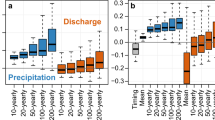Abstract
Methods for estimating the magnitude of extreme floods are reviewed. A method which combines a probabilistic storm transposition technique with a physically-based distributed rainfallrunoff model is described. Synthetic storms with detailed spatial and temporal distributions are generated and applied to the calibrated model of the Brue river basin, U.K. (area 135 km2). The variability of catchment response due to storm characteristics (storm area, storm duration, storm movement, storm shape and within storm variation) and initial catchment wetness conditions is investigated. A probabilistic approach to estimating the return periods of extreme catchment responses is suggested.
Similar content being viewed by others
References
Abbott, M.B., Bathurst, J.C., Cunge, J.A., O'Connell P.E. and Rasmussen, J.: 1986a, ‘An Introduction to the European Hydrological System Systeme Hydrologique Europeen, “SHE”, 1: History and Philosophy of a Physically-Based, Distributed Modelling System’,J. Hydrol. 87, 45–59.
Abbott, M.B., Bathurst, J.C., Cunge, J.A., O'Connell P.E. and Rasmussen, J.: 1986b, ‘An Introduction to the European Hydrological System - Systeme Hydrologique Europeen, “SHE”, 2: Structure of A Physically-Based, Distributed Modelling System’,J. Hydrol. 87, 61–77.
Bathurst, J.C.: 1986a, ‘Physically-Based Distributed Modelling of an Upland Catchment using the Systeme Hydrologique Europeen’,J. Hydrol. 87, 79–102.
Bathurst, J.C.: 1986b, ‘Sensitivity Analysis of the Systeme Hydrologique Europeen’,J. Hydrol. 87, 103–123.
Beven, K.J. and O'Connell, P.E.: 1982, ‘On the Role of Physically-Based Distributed Modelling in Hydrology’, Institute of Hydrology Report no. 81.
Binley, A.M., Beven, K.J., Calver, A. and Watts, L.G.: 1991, ‘Changing Responses in Hydrology: Assessing the Uncertainty in Physically-Based Model Predictions’,Water Res. Res. 27(6), 1253–1261.
Calver, A.: 1988, ‘Calibration, Sensitivity and Validation of a Physically-Based Rainfall-Runoff Model’,J. Hydrol. 103, 103–115.
Collier, C.G.: 1990, ‘Assessing and Forecasting Extreme Rainfall in the United Kingdom’,Weather 45(4), 103–112.
Fleming, G.: 1975,Computer Simulation Techniques in Hydrology. American Elsevier Publishing Company.
Foufoula-Georgiou, E.: 1989, ‘A Probabilistic Storm Transposition Approach for Estimating Exceedance Probabilities of Extreme Precipitation Depth’,Wat. Res. Res. 25(5), 799–815.
Foufoula-Georgiou, E. and Wilson, L.L.: 1990, ‘In Search of Regularities in Extreme Rain Storms’,J. Geophys. Res. 95(D), 2061–2072.
Fontaine, T.A. and Potter, K.W.: 1989, ‘Estimating Probabilities of Extreme Rainfalls’,J. Hydraul. Div. Am. Soc. Civ. Eng. 115(11), 1562–1575.
Franchini, M. and Pacciani, M.: 1990, ‘Comparative Analysis of Several Conceptual Rainfall-Runoff Models’,J. Hydrol. 122, 161–219.
Franchini, M., Helmlinger, K.R., Foufoula-Georgiou, E., and Todini, E.: 1994, ‘Stochastic Storm Transposition Coupled with Rainfall/Runoff Modeling for Estimation of Exceedence Probabilities of Design Floods’. Submitted for publication.
Gupta, V.K.: 1972, ‘Transposition of Storms for Estimating Flood Probability Distribution’. Hydol. Pap. 59. Colorado State Univ., Fort Collins.
Gottschalk, L.: 1985, ‘Hydrological Regionalization of Sweden’.Hydrol. Sci. Jou. 30(1), 65–83.
Hansen, E.M., Screiner L.C. and Miller, J.F.: 1982, ‘Application of Probable Maximum Precipitation Estimate - United States East of the 105th Meridian’. Hydrological report no.52. National Weather Service, National Oceanic and Atmospheric Administration, U.S. Department of Commerce, Washington.D.C.
Hosking, J.R.M., and Wallis, J.R.: 1986a, ‘Palaeflood Hydrology and Flood Frequency Analysis’.Water Res. Res. 22(4), 543–550.
Hosking, J.R.M. and Wallis, J.R.: 1986b ‘The Value of Historical Data in Flood Frequency Analysis’.Water Res. Res. 22(11), 1606–1612.
Huff, F.A.: 1967 ‘Time Distribution of Rainfall in Heavy Storms’.Water. Res. Res. 3(4), 1007–1019.
Institute of Hydrology (IOH): 1991, Surface water archive no. 52010, London.
Mantoglou, A. and Wilson, J.L.: 1982, ‘The Turning Band Method for Simulation of Random Fields using Line Generation by a Spectral Method’.Water Res. Res. 18(5), 1379–1394.
Meteorological Office: 1900–1990,British Rainfall, HMSO, London.
Montgomery, D.C.: 1991,Design and Analysis of Experiment, 3rd. edn., John Wiley & Son.
National Research Council (NRC): 1988,Estimating Probability of Extreme Floods. National Academy Press, Washington.
Natural Environment Research Council (NERC): 1975,Flood Studies Report, Vol.I-IV. London.
O'Connell, P.E.: 1991, ‘A Historical Perspective’. In Bowles, D.S. and O'Connell, P.E. (Editors):Recent Advances in the Modelling of Hydrologic Systems. Kluwer Academic Publishers.
Refsgaard, J.C., Seth, S.M., Bathurst, J.C., Erlich, M., Storm, B., Jorgensen, G.H. and Chandra, S.: 1992, ‘Application of the SHE to Catchment in India. Part 1. General Results’.J. Hydrol. 140, 25–47.
Rogers, C.C.M., Beven, K.J., Moris, E.M. and Anderson, M.G.: 1985, ‘Sensitivity Analysis, Calibration and Predictive Uncertainty of the Institute of Hydrology Distributed Model’.J. Hydrol. 81, 179–191.
Sorooshian, S.: 1991, ‘Parameter Estimation, Model Identification, and Model Validation: Conceptual Type Models’, In Bowles, D.S. and O'Connell, P.E. (Editors):Recent Advances in the Modelling of Hydrologic Systems. Kluwer Academic Publishers.
Shah, S.M.S.: 1988, ‘The Influence of Spatial Variability in Rainfall on the Catchment Response’. Ph.D. Thesis. University of Newcastle upon Tyne. Unpublished.
Sutcliffe, J.V.: 1978, ‘Methods of Flood Estimation, a Guide to Flood Frequency Analysis’, Institute of Hydrology Report no. 49.
Todini, E.: 1988, ‘Rainfall-Runoff Modelling - Past, Present and Future’.J. Hydrol. 100, 341–352.
Wiltshire, S.E.: 1985, ‘Grouping Basins for Regional Flood Frequency Analysis’.Hydrol. Sci. Jou. 30(1), 151–159.
Wiltshire, S.E.: 1986, ‘Identification of Homogeneous Regions for Flood Frequency Analysis’.J. Hydrol. 84, 287–302.
WMO: 1986 ‘Manual for Estimation of Probable Maximum Precipitation’, 2nd edition. Oper. Hydrol. Rep. No.1, WMO No.332, Geneva.
Wigley, T.M.L., Lough, J.M. and Jones, P.D.: 1984, ‘Spatial Patterns of Precipitation in England and Wales and a Revised, Homogeneous England and Wales Precipitation Series’,Climatology 4, 1–25.
Author information
Authors and Affiliations
Rights and permissions
About this article
Cite this article
Suyanto, A., O'Connell, P.E. & Metcalfe, A.V. The influence of storm characteristics and catchment conditions on extreme flood response : A case study based on the brue river basin, U.K.. Surv Geophys 16, 201–225 (1995). https://doi.org/10.1007/BF00665780
Issue Date:
DOI: https://doi.org/10.1007/BF00665780




